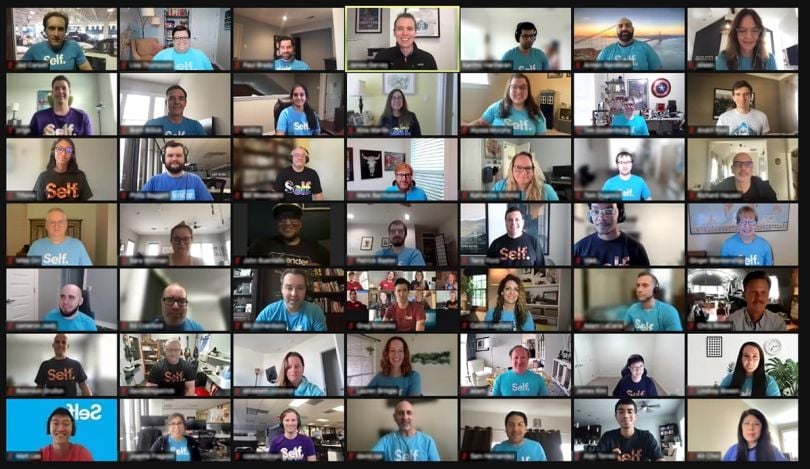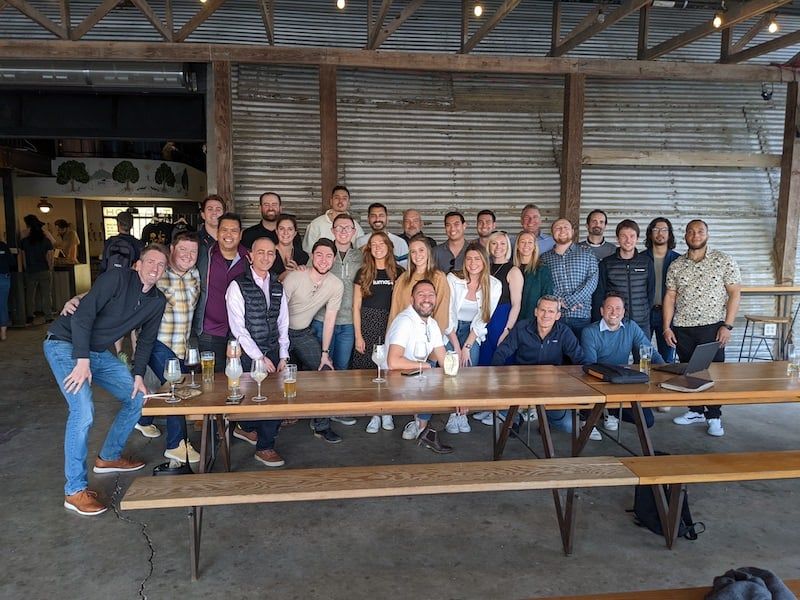Despite a renaissance in inclusivity culture, authenticity — defined as “being one’s own” by philosopher Martin Hiedegger — remains elusive in the workplace.
Psychology researchers Thomas Rigotti and Astrid Emmerich argue that the social mores of the workplace can stifle an employee’s sense of security to be themselves — and constrict real human connection in the process.
“Though being your true self has been considered a major aspiration since ancient times, it is not self-evident that employees can be authentic in their daily working lives,” Rigotti and Emmerich wrote. This truth is made more glaring in a virtual setting, where physical distance magnifies feelings of disconnection.
In light of this existential rub, savvy employers are investing in efforts to foster authentic interactions in the remote workplace.
“The key to creating real human connections in a virtual setting is bringing our whole selves to work,” said Sarah Dutra, director of Marketing at Pinata. “If you want to dye your hair a different color every month or plan to travel the country and live out of your suitcase, we’re here for the journey.”
Supporting employees as they are comes with encouraging benefits: Rigotti and Emmerich report a definitive relationship between self-realization and mental health.
“Authentic behavior at work not only benefits employees in terms of increased well-being, but also the organization as a whole as it leads to increased work ability,” they wrote.
Encouraging employees to bring their true persona to the virtual workplace requires thoughtful action.
“We cheer when we get to meet babies, kids and dogs who join Zoom calls,” said Self Financial Senior Director of Talent Management Nada Lulic. “Personal connections are built in the moments when people share their personal lives.”
Authenticity in the workplace rarely starts with an invitation: It grows in the small moments that make employees feel safe. Perceptive companies celebrate the minutiae that renders human connection whole — quiet notes of appreciation, shared laughter, dog channels on Slack. When Built In Austin sat down with local leaders, it was clear that Austin tech is making good on the famous pledge to keep Austin weird — and closing the distance between remote employees in the process.

Lendflow is a software company that provides embedded credit infrastructure for fintechs, lenders and other software companies to build, embed and launch credit products.
What’s the key to creating real, human connection in the remote workplace?
It starts with culture. Belonging is one of our core values: We always strive to be an organization that centers on inclusion, diversity and equity.
We believe that real human connections are built on authenticity, transparency and trust — so we encourage our team members to bring their authentic selves to work every day and we truly value the unique contribution of each individual.
We truly value the unique contribution of each individual.”
What’s the most successful strategy or initiative you’ve employed for facilitating those kinds of connections?
Since we have distributed teams across the US and abroad, we are constantly implementing new initiatives to bring people together and foster deeper connections.
As part of onboarding, every new team member is encouraged to spend time at the Austin HQ — where they can meet our founders, members of their immediate teams and folks from other parts of the organization. Lendflow also leverages industry events and conferences across the country to meet with local team members in person. Folks who live in the same region are invited to join informal team get-togethers.
Lendflow loves to use Slack to encourage team members to connect over mutual interests, such as “Dogs of Lendflow” and Donut’s technology to facilitate new introductions.
What kind of response have you heard from your team?
The response has been incredible. New hires love spending time with the team at our Austin HQ and taking in the awesome culture, food and overall Austinite vibe.
We’ve gotten great feedback about our local events, so we’re building out our “Lendflow on the go” calendar for the rest of the year.

Hudson River Trading is a fintech company that utilizes a scientific approach to trading financial products.
What’s the key to creating real, human connection in the remote workplace?
In response to the constantly changing new normal, we’ve implemented numerous resources to help employees stay connected, with entire teams dedicated to the mission of meeting our employees’ needs in a hybrid work environment.
Our events and learning and development teams have established programming that support initiatives like wellness, togetherness — one of our core values, DEI celebrations, deep learning and professional training. We use formats that are fun and immersive, even from home.
Our approach is to make it clear that we support managers and employees in finding the balance that works best for them. We also strive to make the office as welcoming, inclusive, and fun as possible, while providing as much support as possible to employees who work remotely.
What’s the most successful strategy or initiative you’ve employed for actually facilitating those kinds of connections?
When we went remote in 2020, we quickly implemented engaging virtual events ranging from joint cooking classes to a fun collaborative music video — which went viral!
One of our partners, Prashant Lal, began a creative weekly video broadcast update to the company, which quickly grew in both popularity and production quality. Two years later, Prascast is now an intricate and widely anticipated production, with several hundred employees tuning in each week for guest speakers, silliness and company updates.
From team highlights to a Thanksgiving pie-tasting with moms of HRTers, Prascast is equal parts hilarious antics and engaging technical conversations. We now run the show both live and remote, empowering employees who are at home or in an office on the other side of the world to still feel connected to HRT. It’s one of our most successful bridges for the hybrid work environment, allowing employees across all teams a look into what’s happening across the company.
Collaborating remotely has given us access to new talent pools and unlocked new solutions for automation and efficiency.”
What impact has this initiative had on your workforce and culture?
With collaboration already ingrained in our company culture, it was a relatively seamless transition to a hybrid work environment. Employees are excited to share ideas and stay connected because that was already in our DNA.
Collaborating remotely has given us access to new talent pools and unlocked new solutions for automation and efficiency. With some teams spanning multiple offices, collaboration has become even more inclusive: Now, everyone can be part of the meeting.

Self Financial is a fintech company that helps underserved and credit-invisible people build and establish their credit.
What’s the key to creating real, human connection in the remote workplace?
Personal connections are built in the moments when people share about their personal lives, ask each other’s opinions, solve complex work problems or celebrate wins. In the office, there are spontaneous opportunities to connect and we bring people into Austin as frequently as possible for department meetings or the holiday party. We also build those opportunities virtually whenever we can.
One example is through our #photos channel on Slack that includes personal and company photos. We often see what our teammates are up to in real-time — games, concerts, even getting engaged — so we can be together in spirit, if not in person. We share photos of company happenings, like our sponsorship of the Moody Center in Austin, which reinforces that “I’m right there with the team!” feeling.
We embrace bringing your whole self to work and cheer when we get to meet babies, kids and dogs who join Zoom calls. One pup is famous for their roof-raising snore during weekly ops calls!
What’s the most successful strategy or initiative you’ve employed for actually facilitating those kinds of connections?
We keep information and two-way communication flowing. Our approach to communication and supporting connections is varied and consistent. Our most successful strategy is giving our employees many opportunities to tell us what they want and need through surveys — and we follow through.
For example, employees asked to hear more about employee recognition, so we added features in our monthly newsletter highlighting employees on the move and spotlights an employee each month. Our weekly all-hands meeting brings the company together in one Zoom call. It is a combination of leadership sharing mission-critical information and establishing personal connections — like our new employee introductions.
New team members have the opportunity to share stories about their first experience with credit, hearkening back to our mission. Our “ask management anything” program allows team members to really ask anything anonymously and they will get an answer that is either addressed to the full company during the all-hands meeting, or answered directly.
What kind of response have you heard from your team?
We regularly ask for, share and act upon feedback from our employees. Two annual surveys inform strategic initiatives: our annual employee survey and our DEI survey. Our annual employee survey provides us with a big-picture view of how our team experiences working at Self.
SELF’S EMPLOYEE DEVELOPMENT AND RECOGNITION ACTION TEAM
Pinata is a blockchain company providing a multimedia hub for NFTs and creative content of all kinds.
What’s the key to creating real, human connection in the remote workplace?
At Pinata, we strive to be intentional with every member we bring on. Although a remote workplace isn’t for everyone, it actually benefits a lot of our team members who want more time with their families or are pursuing other interests that an office job would not favor.
The key to creating real human connections along the way is bringing our whole selves to work. We welcome and embrace new team members for who they are — and I said earlier, if you want to dye your hair a different color every month or plan to travel the country and live out of your suitcase, we’re here for the journey and love to cheer our members along the way.
What’s the most successful strategy or initiative you’ve employed for actually facilitating those kinds of connections?
When Pinata started growing across all departments earlier this year, we knew we needed to find a way to allow people to connect with each other to keep our team feeling close. We started having bi-weekly virtual coffee times that allow you to be paired with someone you haven’t met yet on the team. These 20 to 30 minute calls typically help you break the ice with fun questions that help find common hobbies and interests — but many of us use the time to share about our personal life or discover something new about a team member’s contribution to a project.
People aren’t as intimidated to jump on a call when they see some familiar smiles they’ve gotten to know more personally.”
What impact has this initiative had on your workforce and/or culture?
Going from five members this time last year to now having a team of 30, it’s been really fun to see how the team is growing in unity. People aren’t as intimidated to jump on a call when they see some familiar smiles they’ve gotten to know more personally. Since starting our virtual coffee meets, our team members have gained a stronger sense of empathy across the organization. In turn, this has helped foster a positive culture: one that people are proud to be a part of.

LumApps is a digital workplace and intranet where users can access corporate content, news, documents, communities and specific business applications all in one place.
What’s the key to creating real, human connection in the remote workplace?
With the drastic shift to remote work happening over the last few years, many of us have been asking this question: How do we create a sense of connection in an environment taking place behind screens?
We focus on listening and learning from the feedback of our employees because we believe no one knows what they need better than them. By encouraging employees to provide feedback, we build trust and connection across the company creating a safe space for Lumies.
What’s the most successful strategy or initiative you’ve employed for actually facilitating those kinds of connections?
At LumApps, we embrace the importance of recognizing the human aspect of our employees. We acknowledge the lives we have going on outside of work by promoting flexibility and ensuring a healthy work-life balance. We make conscious efforts to support each other when things come up and take the overall wellness of our employees seriously.
What impact has this initiative had on your workforce and culture?
One of our exciting initiatives made towards achieving human connection is offering an in person onboarding to our new employees by flying them to our office in Austin, Texas and hosting them for the week. Every month we give our new hires the option to enjoy their onboarding in person where they get the chance to meet other employees. We strongly feel that this creates a sense of connection across teams and allows for employees to get a genuine feel for our company culture — while having fun along the way.

BigCommerce is a cloud and e-commerce company seeking to bring online selling and features once reserved for multi-billion-dollar companies to the masses.
What’s the key to creating real, human connection in the remote workplace?
I think it’s very similar in many ways to real, in-person connection. Human connection is about relationships. It’s about making sure that one gives and receives appreciation and understanding, regardless of whether you’re two feet apart or two time zones apart. It’s about listening to understand, always seeking additional context and assuming the good in what you see or hear from the other person.
Remotely, I always try to put in extra effort to ensure I am providing more context and explanation than I normally would if someone was in a shared workspace.
It’s about making sure that one gives and receives appreciation and understanding, regardless of whether you’re two feet apart or two time zones apart.”
What’s the most successful strategy or initiative you’ve employed for actually facilitating those kinds of connections?
Right now, it’s only natural that my mind first goes to our Ukraine team. It’s so important that they know we are present and thinking of them 24/7. We make sure we have very frequent contact points where we start first by listening to the other person — in this case, the Ukraine team. We discuss the other person’s needs, then express our own questions and concerns, and we always close with caring. We express best wishes for the team’s safety and security every day. We thank them for all that they are doing to take care of others on the team. I think those things are key: Listening and caring never gets old for human beings.
Doing that consistently and letting them know that someone is thinking about them is a pattern that we’ve used for Ukraine, but it is also one that could apply to any remote location. Regardless of distance, we all want to know that we have someone at our place of work who cares for us.
Regardless of distance, we all want to know that we have someone at our place of work who cares for us.”
What kind of response have you heard from your team?
Our Ukrainian team members tell us they feel connected and cared for. Even when there have been requests for types of assistance we couldn’t provide, our employees have thanked us for our transparency and partnership. Remarkably, our Ukraine team told us that they know we are doing everything within our power to provide resources and pass them information.
I’m convinced that we received a positive response even in situations where the answer fell short of their hopes and expectations because we invested in the relationship upfront. Nobody expects you to do the impossible. People want to know that you are invested in them, you understand their needs and are doing your very best to meet those — and to be honest when you can’t.
In this case, we’ve done our very best to demonstrate caring from one side of the world to another. The end result is an ongoing relationship in which both sides are fully invested.
















